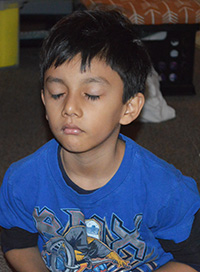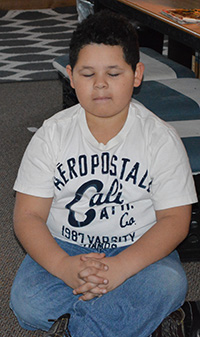Every morning after the bell rings, Godfrey Early Childhood Center students start daydreaming. They close their eyes, sit quietly and think of whatever they want.

In kindergarten teacher Eryn Watson’s room, the calming, reflective activity flows into the start of learning. After opening their eyes, students talk about goals for the day: listening, helping a friend, earning reward points. “Why do we do this?” Watson asked on a recent Monday morning.
“So we can calm down,” students answered. “So we can rest.”
“It’s good for our brains,” added kindergartner Axcel Deleon-Magana.
Watson agreed. “We do it so we are all happy,” she told them. “I want you to have a wonderful, wonderful day.”

Moments spent lost in thought are part of the ECC staff’s effort to create mindful classrooms. Principal Peter Geerling started daydreaming time this school year to help students develop an awareness of their thoughts and emotions. Research shows that mindfulness interventions improve attention, self-control, emotional resilience, memory and immune response.
“It’s just giving quiet self-reflection time in this noisy, noisy world,” Geerling said.
The meditative sessions are just one component of how Godfrey-Lee staff members are helping students relax, feel more present and safe and, as a result, be more successful. Students also spend 30 minutes a week learning techniques to help navigate and self-regulate emotional stress with Amber Kilpatrick, creator of The Mindful Classrooms Project, and other instructors. Congress Elementary School, in Grand Rapids Public Schools, also uses Kilpatrick’s program.

A More Mindful, Sensitive Place
At Godfrey Lee Public Schools, a largely Hispanic district where more than 80 percent of students qualify for free or reduced-price lunch and many live below the poverty line, educators see mindfulness as an important part of another focus: creating a trauma-sensitive environment.
Social worker Lisa VandeWaa and Geerling have attended training on Trauma Sensitive Schools and staff is also being trained. They are learning best approaches to teach students who have faced trauma. Along with poverty, many students deal with hunger and stressful family situations. “Everybody comes to school with baggage you can’t see, even adults,” Geerling said.
It’s all about creating human connections in a society obsessed with numbers and data, where focusing on proficiency standards can’t be done without meeting basic needs — Godfrey Early Childhood Center Principal Peter Geerling

Responding to students who have faced trauma requires sensitivity. VandeWaa said traditional disciplinary practices aren’t effective and can even be counterproductive. Instead of “time out,” for example, ECC students are often given time to used their mindfulness techniques in the office until they are calm enough to talk. They aren’t isolated, because that can exacerbate the problem.
“Trauma sensitivity isn’t a curriculum; it’s just a shift in your mindset and how you approach things,” VandeWaa said. Instead of ‘What’s wrong with this kid?’ you might instead say, ‘What happened to this little peanut?’ which really changes how you would approach what’s going on.”
It’s all about creating human connections in a society obsessed with numbers and data, where focusing on proficiency standards can’t be done without meeting basic needs, Geerling said. Part of that is making sure students feel safe.

But even getting students to feel comfortable daydreaming with their eyes closed is a process, Geerling said.
“For children in poverty, to try to close your eyes for a minute creates so much anxiety because it takes so much trust to have your eyes closed and know nothing is going to happen,” he said. “If we get everybody in the building to sit there with their eyes closed for three minutes, we have passed a huge, huge hurdle…They feel safe. That’s huge.”
CONNECT









